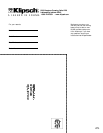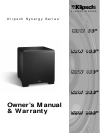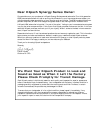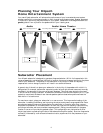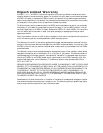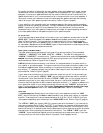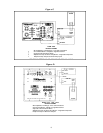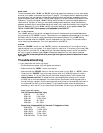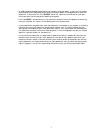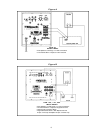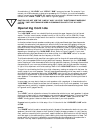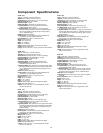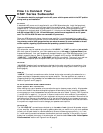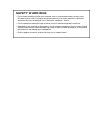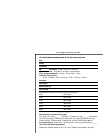6
HIGH PASS
This switch selects either “40 Hz” or “80 Hz” as the high pass filter frequency for your main speak-
ers when your system is connected as per figure C (page 9). This diagram shows a separate pre-amp
and power amp, but also applies to integrated components (such as receivers) possessing pre-amp
output and power amp input jacks. The high pass frequency is the point below which sound will be
filtered out. Typically the higher “80 Hz” setting would be used for smaller bookshelf speakers to
relieve them of the strain of having to reproduce the deep bass frequencies. Larger floorstanding
speakers are better able to handle bass energy and usually only need reinforcement at the lowest fre-
quencies. Because of this, the “40 Hz” setting is typically selected for larger speakers. Note: The
140 Hz “HIGH PASS” filter frequency is not adjustable on the KSW 50.
AV +3 dB/AV Boost
The “+3 dB” setting of this switch increases the volume of the subwoofer by three decibels above
the volume set by the “LEVEL” control. This allows for two repeatable volume settings if you desire
a different amount of bass for music recordings and movies soundtracks. The “+3 dB” setting
should not be used when the “LEVEL” control is adjusted to a high volume. This avoids overdriv-
ing or distorting the subwoofer. This is not applicable for the KSW 50.
POWER
When the “POWER” switch is in the “AUTO” position, the subwoofer will turn itself on when it
receives a signal from your system. If no signal is sent for a period of 15 minutes (4.5 minutes, KSW
50), the sub will turn itself off. A red power light indicates a standby mode in which the amplifier
will turn on when it senses a signal. Green indicates the subwoofer is on and receiving a signal.
Note: The KSW 50 has a single red color power light that lights only when the subwoofer is receiv-
ing a signal.
Troubleshooting
• If your subwoofer has little or no output:
– Double check your power (AC) and system connections.
– Make sure that the “LEVEL” control is turned up.
– Make sure that the “POWER” switch on the rear control panel is in the “ON” or “AUTO” position.
– Check that the “POWER” light on the rear control panel is lit (KSW 50 lights only when a
signal is present). If it is not, check the AC fuse. When changing the AC main’s power fuse,
unplug the power cord first. To access the fuse, use the appropriate screwdriver to unscrew
the flush cap on the fuse receptacle. If the fuse is blown (the filament inside the glass tube is
burned through), replace it with the same type and value printed on the amplifier panel next to
the fuse holder (or refer to the chart below). If the fuse blows again when the subwoofer is
powered up, return the unit to your authorized Klipsch dealer for servicing by qualified personnel.
Fuse types and values:
120 Volt Versions (Slow Blow Type)
KSW 50 2A / 250V
KSW 100 2.5A / 250V
KSW 150 3.15A / 250V
KSW 200 5A / 250V
KSW 300 5A / 250V
Export Dual Voltage and 230 Volt Versions (T Designator on Fuse)
KSW 50DV T1A / 250V
KSW 100DV T1.25A / 250V
KSW 150DV T1.6A / 250V
KSW 200DV T2.5A / 250V
KSW 300 230V T3.15A / 250V



